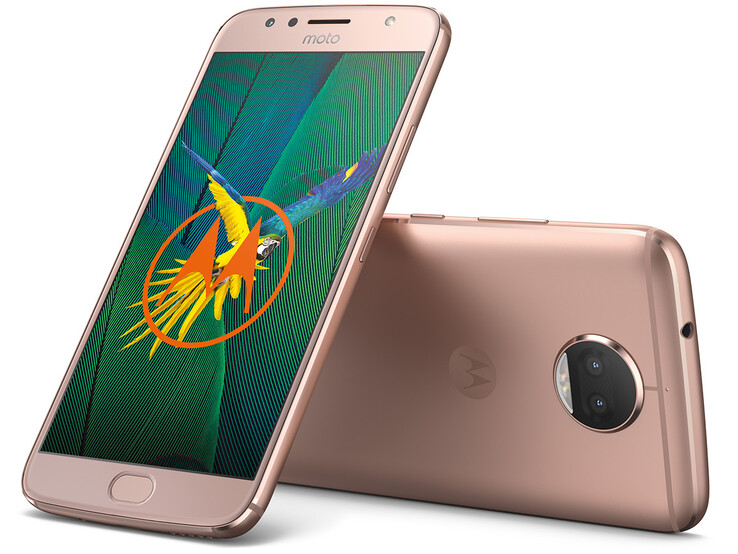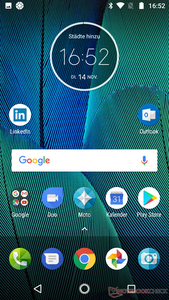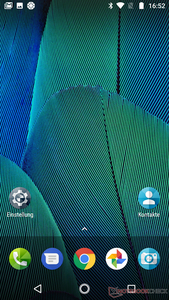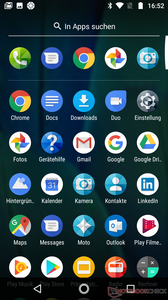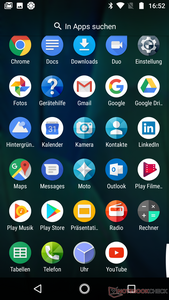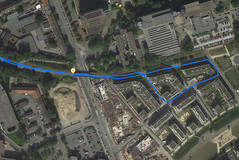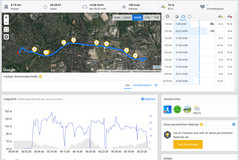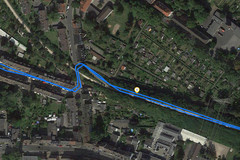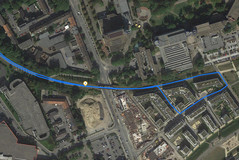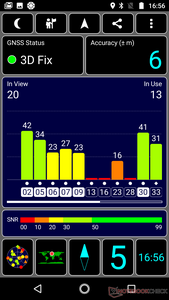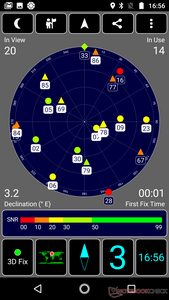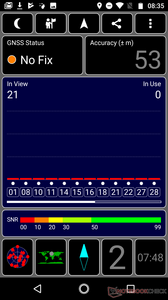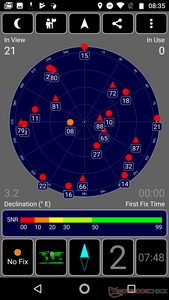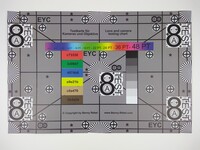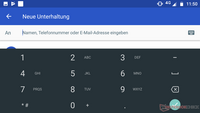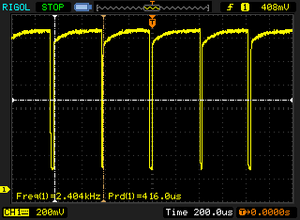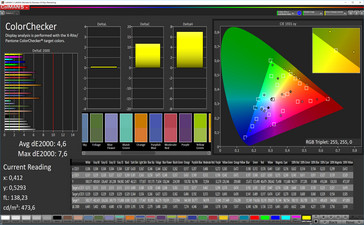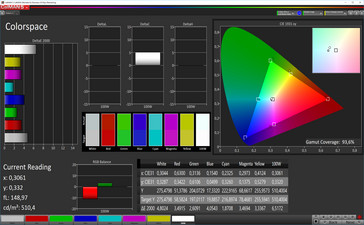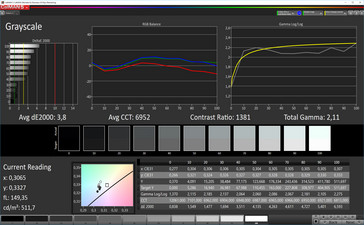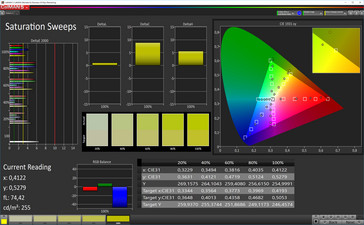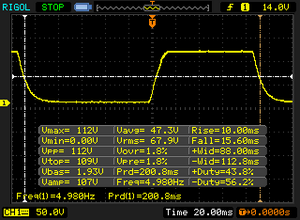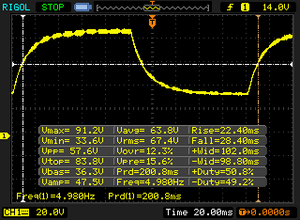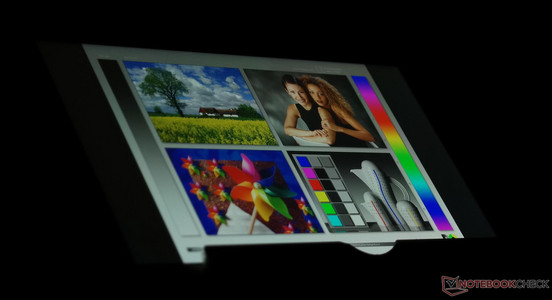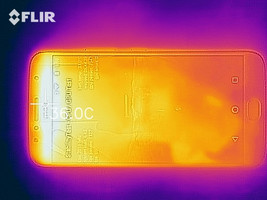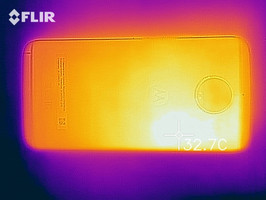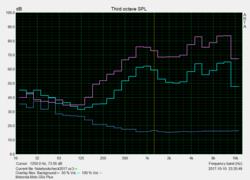Motorola Moto G5s Plus Smartphone Review

The Motorola Moto G5s Plus succeeds the G5 Plus, a mid-range smartphone that we tested on Labor Day last year. The Moto G5 Plus impressed us during our tests, with only the rear camera being rather average despite its large camera housing. Motorola released the G5s Plus six months after the release of the G5 Plus. Little seems to have changed between the two devices at a first glance.
However, Motorola has added an additional rear-facing camera and increased the screen size from 5.2 to 5.5-inches. The G5s Plus maintains the same 1920x1080 resolution as its predecessor and uses the same Qualcomm Snapdragon 625 SoC and Adreno 506 GPU too. Likewise, the G5s Plus shares the same 3 GB RAM and 32 GB of internal storage as its predecessor.
The rear-facing camera has been upgraded to dual 13 MP sensors with f/2.0 aperture and a dual-tone LED flash. The front-facing camera has been upgraded too, from 5 MP to 8 MP with an f/2.0 aperture and an LED flash.
So, it looks as though the G5s Plus improves upon the downsides of a device for which we have already given a recommendation. We will put the G5s Plus through our usual set of tests to see whether the device can match our expectations.
We will be comparing the G5s Plus against not only its predecessor but also the Sony Xperia XA1, the Huawei Nova and the Xiaomi Mi Max 2. The latter two devices are equipped with the same SoC, so they should be good examples of class performance against which to compare the G5s Plus.
It is worth bearing in mind that Motorola ceased trading in 2011, with the consumer brand being spun off into Motorola Mobility. Google bought Motorola Mobility in 2011, under which it served as a subsidiary until 2014. Lenovo then bought the brand in 2014 and continues to run it as a subsidiary. In this review, we will be referring Lenovo & Motorola Mobility as Motorola for the sake of simplicity.
Case
The G5s Plus is decked out in an aluminum case, which is a significant improvement visually and tactilely over the previous generation’s plastic case. The G5s Plus is available in Lunar Gray and Fine Gold, both of which look great. The workmanship is impeccable too. The case is not only stable but is also stiff. Applying pressure with our hands leaves neither a mark on the case nor on the screen. Motorola has done a great job here.
Motorola has got the design spot on, except for the camera hump which makes the phone wobbly on flat surfaces. This is a minor quibble though as many smartphones are currently designed like this. One noticeable compromise between Moto generations is the battery, which has gone from being removable to built-in. Again, many smartphone manufacturers have moved towards built-in batteries, so this isn’t a shocking change.
Connectivity
The G5s Plus is powered by a Qualcomm Snapdragon 625 SoC with Adreno 506 graphics, just like its predecessor. The G5s Plus comes with 3 GB RAM and 32 GB of internal storage. These should be sufficient for daily use and are practically entry-level for mid-range devices these days. There are devices with 4 GB RAM and 64 GB storage in this price range, but these are typically by lesser-known Chinese manufacturers like Blackview or Doogee.
The G5s Plus supports dual SIM and microSD card expansion up to 128 GB. There is a caveat though as the device accepts either two nano-SIMs or one nano-SIM and a microSD card, but not both. These are housed in a SIM tray on the left-hand side of the device.
The other ports are relatively standard for a mid-range device released in 2017. The power button and volume rocker are on the right-hand side, while there is a micro USB port on the bottom and a 3.5 mm jack up top.
Software
The G5s Plus ships with Android Nougat 7.1. At the time of the original German review in November 2017, our test device had an Android security patch level dated June 1, 2017. Motorola updated the Moto G5s Plus to Android 8.0.0 Oreo in February this year, promising better performance and longer battery life.
There is some preinstalled software in addition to the near stock Android experience. These include Moto Apps and apps by Microsoft like LinkedIn and Outlook. While the Moto Apps are useful and well explained, we do have one gripe during the initial set-up process. Moto Apps asks a series of questions concerning permission to send user data among other things, which becomes laborious on top of the other stock Android set-up steps.
Motorola has implemented gestures that improve overall usability over stock Android. For example, the flashlight and camera can be configured to turn on with a flick of a wrist. Another useful feature is flip to mute, whereby all calls are muted if the G5s Plus is facing screen down on a flat surface. Motorola includes its Moto Display software too, which enables an always-on display and night mode. Night mode increases the display’s color temperature to reduce eye strain and fatigue at night.
The background in our screenshots below is the only background that comes with the Moto G5s Plus. While this is not an issue per se, we found the striped effect rather jarring and could imagine that some users with sensitive eyes could struggle with this background too.
Communication & GPS
The G5s Plus supports IEEE 802.11 a/b/g/n on 2.4 GHz and 5 GHz networks. The G5s Plus scored over 100 Mb/s in both our iperf3 Client Wi-Fi speed tests, scoring 121 Mb/s and 108 Mb/s in receive and transmission tests, respectively. Our test device is only consistently outperformed by the Xiaomi Mi Max 2 because of the latter’s support for the faster 802.11 ac protocol. In practice, this will not make much of a difference as most home broadband is not fast enough to take advantage of 802.11 ac Wi-Fi. The G5s Plus is equaled by its predecessor in these tests, which makes sense since both devices use the same modem.
The G5s Plus supports 4G LTE bands B1, 3, 5, 7, 18, 19, 20, 26, 28, 38 and 40. It also supports UMTS 850 MHz, Japan 850 MHz, 900 MHz, 1900 MHz and 2100 MHz. Likewise, there is GSM support for 850 MHz, 900 MHz, 1800 MHz and 1900 MHz.
| Networking | |
| iperf3 transmit AX12 | |
| Xiaomi Mi Max 2 | |
| Sony Xperia XA1 | |
| Motorola Moto G5s Plus | |
| Lenovo Moto G5 Plus | |
| Huawei Nova | |
| iperf3 receive AX12 | |
| Xiaomi Mi Max 2 | |
| Lenovo Moto G5 Plus | |
| Motorola Moto G5s Plus | |
| Sony Xperia XA1 | |
| Huawei Nova | |
We took our test device on a bike ride with a Garmin Edge 500 to see how GPS accurate the G5s Plus is compared with a professional navigation device. The results are similar, with the G5s Plus recording a 0.4 km longer total distance than the Garmin. The G5s Plus plots a rougher course than the Garmin but performed well overall given its mid-range pricing.
The G5s Plus supports A-GPS, GPS and GLONASS. While our test device is accurate to six meters outside, it still takes a relatively long time to fix its location. This is a huge improvement from the 12-meter accuracy that its predecessor achieved. However, like its predecessor, the G5s Plus cannot locate us indoors.
Telephone Function & Call Quality
The G5s Plus uses the Google Phone app as part of its near stock Android experience. Call quality is decent, with our call partner coming across clearly and the call sounding sufficiently loud. The microphone does pick up some background noise at our end, but this does not affect the conversation overall.
Motorola does not include headphones in the box.
Cameras
The Moto G5s Plus has dual rear-facing 13 MP cameras and an 8 MP front-facing one. While those are good specifications for the money, the results are not always convincing. Macro shots of small beetles or flowers demonstrate the rear cameras strong performance, but low-light conditions highlight its shortcomings. While low-light shots are passable, the quality of them is not great. The dual-camera system can also create bokeh effect photos. While the depth of field is noticeable, the algorithm creates a visible border around the object in focus and struggles to delineate between the object and the blurred background.
One thing worth mentioning is the camera app, which is outstanding. The camera can be configured to open with a flick of the wrist, which is useful. Not only does it offer a selectable focus, but it also has a quick setting ring for altering the exposure, which can be useful in certain lighting situations. These features prove rather useless though if the camera fails to focus perfectly.
We are not huge fans of the camera housing though. The porthole protrudes from the rear of the device, which only reduces the device’s stability on a flat surface. Other manufacturers have incorporated a dual-camera array with LED flash flush against the case. The camera housing is merely for design and does not help the cameras take better shots than if the sensors were flush against the rear case.
Our test device performed well under controlled lighting conditions too. Our test chart is sharp and in focus. Color accuracy is lacking though. We have included our ColorChecker test as a reference, with the desired color in the lower half of each patch. As you can see, the G5s Plus mainly reproduces colors too brightly and rarely achieves the desired color. While white is perfectly reproduced, gray tones are much darker than their reference color. Conversely, the black tone is not as dark as the reference color. Overall, color intensity falls just short of the reference colors.
Accessories and Warranty
Motorola only included the essential accessories with our test device. In the box is a SIM tool to open the card tray, a Micro USB cable and a charger. The charger charges our test device in around 90 minutes from flat. Motorola does not currently offer any additional accessories for the G5s Plus.
There are some instructions too that are written in English, German, French, Spanish, Italian, Polish and Dutch.
Motorola is rather shaky on warranty length. While Moto devices typically have 24 months device warranty and 12 months battery warranty, there is no express warranty length in the literature included in the box. Please see our Guarantees, Return Policies & Warranties FAQ for country-specific information.
Input Devices & Operation
The G5s Plus uses stock Android’s onscreen navigation buttons rather than hardware ones. This is the direction that Google recommends manufacturers taking, but hardware buttons would have made more sense from a design point of view. The fingerprint reader is below the display and is customizable thanks to Moto software. The fingerprint reader unlocks and locks the display by default, but it can double up as an all-in-one onscreen navigation button replacement. A tap on the reader becomes the gesture for the home button, while a long press brings up the Google Assistant. A left swipe acts as the back button and a right swipe brings up recent apps. The orientation of these can be reversed if required. The drawback of enabling this though is that the ability to lock the display with the fingerprint reader is disabled.
The G5s Plus has a 10-point multitouch display that responds quickly and accurately to inputs. Google’s Gboard is the default keyboard, with the language set to English as standard. The keyboard can be replaced with others that are downloadable from the Google Play Store if required.
Display
The G5s Plus has an IPS display, which has now become the standard for mid-range smartphones. The 5.5-inch display has a 1920x1080 resolution that compares well against the competition. We measured an average maximum brightness of 500 cd/m² with adaptive brightness on and a brightness uniformity of 90%. Both values are comparable to those of our comparison devices. While 500 cd/m² is a good value, the G5s Plus can be cranked up to 656 cd/m² on manual brightness.
| |||||||||||||||||||||||||
Brightness Distribution: 90 %
Center on Battery: 512 cd/m²
Contrast: 1463:1 (Black: 0.35 cd/m²)
ΔE ColorChecker Calman: 4.6 | ∀{0.5-29.43 Ø4.77}
ΔE Greyscale Calman: 3.8 | ∀{0.09-98 Ø5}
Gamma: 2.11
CCT: 6952 K
| Motorola Moto G5s Plus IPS, 1920x1080, 5.5" | Huawei Nova IPS, 1920x1080, 5" | Xiaomi Mi Max 2 IPS, 1920x1080, 6.4" | Lenovo Moto G5 Plus IPS, 1920x1080, 5.2" | Sony Xperia XA1 IPS, 1280x720, 5" | |
|---|---|---|---|---|---|
| Screen | -4% | -12% | -15% | -34% | |
| Brightness middle (cd/m²) | 512 | 493 -4% | 530 4% | 503 -2% | 522 2% |
| Brightness (cd/m²) | 500 | 485 -3% | 523 5% | 495 -1% | 499 0% |
| Brightness Distribution (%) | 90 | 94 4% | 92 2% | 96 7% | 92 2% |
| Black Level * (cd/m²) | 0.35 | 0.44 -26% | 0.42 -20% | 0.31 11% | 0.74 -111% |
| Contrast (:1) | 1463 | 1120 -23% | 1262 -14% | 1623 11% | 705 -52% |
| Colorchecker dE 2000 * | 4.6 | 4.2 9% | 5.9 -28% | 6.2 -35% | 4.2 9% |
| Colorchecker dE 2000 max. * | 7.6 | 6.6 13% | 10.6 -39% | 9.8 -29% | 11.5 -51% |
| Greyscale dE 2000 * | 3.8 | 3.8 -0% | 4.1 -8% | 6.8 -79% | 6.4 -68% |
| Gamma | 2.11 104% | 2.39 92% | 2.28 96% | 2.33 94% | 2.18 101% |
| CCT | 6952 93% | 7438 87% | 7129 91% | 8113 80% | 7044 92% |
* ... smaller is better
Screen Flickering / PWM (Pulse-Width Modulation)
| Screen flickering / PWM detected | 2404 Hz | ≤ 7 % brightness setting | |
The display backlight flickers at 2404 Hz (worst case, e.g., utilizing PWM) Flickering detected at a brightness setting of 7 % and below. There should be no flickering or PWM above this brightness setting. The frequency of 2404 Hz is quite high, so most users sensitive to PWM should not notice any flickering. In comparison: 53 % of all tested devices do not use PWM to dim the display. If PWM was detected, an average of 8081 (minimum: 5 - maximum: 343500) Hz was measured. | |||
CalMAN results demonstrate that the G5s Plus has an above average display. Our test device has a 0.35 cd/m² black value and a 1,463:1 contrast ratio, both of which are within the expected range for non-AMOLED displays. Likewise, our test device performed well for a mid-range smartphone in DeltaE 2000. Upon closer inspection of the CalMAN charts the display has a slight turquoise tint. This is unnoticeable to the naked eye though. Overall, the display is a big improvement of the G5 Plus, which had a strong blue tint to it.
Display Response Times
| ↔ Response Time Black to White | ||
|---|---|---|
| 25.6 ms ... rise ↗ and fall ↘ combined | ↗ 10 ms rise | |
| ↘ 15.6 ms fall | ||
| The screen shows relatively slow response rates in our tests and may be too slow for gamers. In comparison, all tested devices range from 0.1 (minimum) to 240 (maximum) ms. » 60 % of all devices are better. This means that the measured response time is worse than the average of all tested devices (20.2 ms). | ||
| ↔ Response Time 50% Grey to 80% Grey | ||
| 50.8 ms ... rise ↗ and fall ↘ combined | ↗ 22.4 ms rise | |
| ↘ 28.4 ms fall | ||
| The screen shows slow response rates in our tests and will be unsatisfactory for gamers. In comparison, all tested devices range from 0.165 (minimum) to 636 (maximum) ms. » 87 % of all devices are better. This means that the measured response time is worse than the average of all tested devices (31.6 ms). | ||
The G5s Plus is usable in the shade but using the display in direct sunlight proved difficult. The glossy finish isn’t too reflective, but the reflections are sufficient enough to render reading what’s on the display a struggle.
Performance
As mentioned previously, the G5s Plus is powered by the same SoC as its predecessor. The Xiaomi Mi Max 2 and the Huawei Nova are powered by the Qualcomm Snapdragon 625 too. By contrast, the Sony Xperia XA1 is equipped with a MediaTek Helio P20 (LP4) MT6757 SoC. All devices performed within 10% of each other in our benchmarks, but the G5s Plus is often relegated to the bottom of our comparison tables. Moreover, the G5 Plus often beat its successor in these benchmarks too. Overall, performance is okay at this price, but the benchmark results suggest that the G5s Plus isn’t getting the best performance from its SoC.
| AnTuTu v6 - Total Score (sort by value) | |
| Motorola Moto G5s Plus | |
| Huawei Nova | |
| Xiaomi Mi Max 2 | |
| Lenovo Moto G5 Plus | |
| Sony Xperia XA1 | |
| PCMark for Android | |
| Work performance score (sort by value) | |
| Motorola Moto G5s Plus | |
| Huawei Nova | |
| Xiaomi Mi Max 2 | |
| Lenovo Moto G5 Plus | |
| Sony Xperia XA1 | |
| Work 2.0 performance score (sort by value) | |
| Motorola Moto G5s Plus | |
| Xiaomi Mi Max 2 | |
| Lenovo Moto G5 Plus | |
| Sony Xperia XA1 | |
| Geekbench 4.4 | |
| 64 Bit Single-Core Score (sort by value) | |
| Motorola Moto G5s Plus | |
| Xiaomi Mi Max 2 | |
| Lenovo Moto G5 Plus | |
| Sony Xperia XA1 | |
| 64 Bit Multi-Core Score (sort by value) | |
| Motorola Moto G5s Plus | |
| Xiaomi Mi Max 2 | |
| Lenovo Moto G5 Plus | |
| Sony Xperia XA1 | |
| Compute RenderScript Score (sort by value) | |
| Motorola Moto G5s Plus | |
| Lenovo Moto G5 Plus | |
| Sony Xperia XA1 | |
| GFXBench (DX / GLBenchmark) 2.7 | |
| T-Rex Onscreen (sort by value) | |
| Motorola Moto G5s Plus | |
| Huawei Nova | |
| Xiaomi Mi Max 2 | |
| Lenovo Moto G5 Plus | |
| Sony Xperia XA1 | |
| 1920x1080 T-Rex Offscreen (sort by value) | |
| Motorola Moto G5s Plus | |
| Huawei Nova | |
| Xiaomi Mi Max 2 | |
| Lenovo Moto G5 Plus | |
| Sony Xperia XA1 | |
| GFXBench 3.0 | |
| on screen Manhattan Onscreen OGL (sort by value) | |
| Motorola Moto G5s Plus | |
| Huawei Nova | |
| Xiaomi Mi Max 2 | |
| Lenovo Moto G5 Plus | |
| Sony Xperia XA1 | |
| 1920x1080 1080p Manhattan Offscreen (sort by value) | |
| Motorola Moto G5s Plus | |
| Huawei Nova | |
| Xiaomi Mi Max 2 | |
| Lenovo Moto G5 Plus | |
| Sony Xperia XA1 | |
| GFXBench 3.1 | |
| on screen Manhattan ES 3.1 Onscreen (sort by value) | |
| Motorola Moto G5s Plus | |
| Huawei Nova | |
| Xiaomi Mi Max 2 | |
| Lenovo Moto G5 Plus | |
| Sony Xperia XA1 | |
| 1920x1080 Manhattan ES 3.1 Offscreen (sort by value) | |
| Motorola Moto G5s Plus | |
| Huawei Nova | |
| Xiaomi Mi Max 2 | |
| Lenovo Moto G5 Plus | |
| Sony Xperia XA1 | |
| GFXBench | |
| on screen Car Chase Onscreen (sort by value) | |
| Motorola Moto G5s Plus | |
| Huawei Nova | |
| Xiaomi Mi Max 2 | |
| Lenovo Moto G5 Plus | |
| Sony Xperia XA1 | |
| 1920x1080 Car Chase Offscreen (sort by value) | |
| Motorola Moto G5s Plus | |
| Huawei Nova | |
| Xiaomi Mi Max 2 | |
| Lenovo Moto G5 Plus | |
| Sony Xperia XA1 | |
| Lightmark - 1920x1080 1080p (sort by value) | |
| Sony Xperia XA1 | |
| Basemark X 1.1 | |
| Medium Quality (sort by value) | |
| Sony Xperia XA1 | |
| High Quality (sort by value) | |
| Sony Xperia XA1 | |
| Basemark ES 3.1 / Metal - offscreen Overall Score (sort by value) | |
| Sony Xperia XA1 | |
| Epic Citadel - Ultra High Quality (sort by value) | |
| Sony Xperia XA1 | |
The G5s Plus performed similarly in our browser benchmarks. While the G5s Plus scored 14% lower than its predecessor in JetStream 1.1, the reverse was true in Mozilla Kraken 1.1. These discrepancies between the same SoC may be somewhat attributable to different versions of Chrome. For example, we tested the G5s Plus on Chrome 62, whereas we originally tested the G5 Plus on Chrome 57, such is the volume of Chrome updates.
| JetStream 1.1 - Total Score | |
| Lenovo Moto G5 Plus (Chrome 57) | |
| Huawei Nova (Chrome 55.0.2883.91) | |
| Sony Xperia XA1 (Chrome 58) | |
| Motorola Moto G5s Plus (Chroem Version 62) | |
| Xiaomi Mi Max 2 (Chrome Version 60) | |
| Octane V2 - Total Score | |
| Huawei Nova (Chrome 55.0.2883.91) | |
| Motorola Moto G5s Plus (Chroem Version 62) | |
| Lenovo Moto G5 Plus (Chrome 57) | |
| Xiaomi Mi Max 2 (Chrome Version 60) | |
| Sony Xperia XA1 (Chrome 58) | |
| Mozilla Kraken 1.1 - Total | |
| Sony Xperia XA1 | |
| Xiaomi Mi Max 2 (Chrome Version 60) | |
| Motorola Moto G5s Plus (Chroem Version 62) | |
| Huawei Nova (Chrome 55.0.2883.91) | |
| Lenovo Moto G5 Plus (Chrome 57) | |
| WebXPRT 2015 - Overall | |
| Lenovo Moto G5 Plus (Chrome 57) | |
| Sony Xperia XA1 (Chrome 58) | |
| Huawei Nova (Chrome 55.0.2883.91) | |
* ... smaller is better
The G5s Plus is equipped with 32 GB of internal storage. This can be expanded with a microSD card, which according to Motorola, could be up to a 128 GB card.
The G5s Plus is 32% behind its predecessor in AndroBench. The G5s Plus in on par with our comparison devices though.
We presume that the G5s Plus has the same microSD card reader installed as its predecessor. While the G5s Plus has marginally faster microSD card read speeds, these are within normal fluctuations. As such, the G5s Plus has similar microSD card performance as its predecessor.
For reference, we test our devices with a Toshiba Exceria Pro M501 microSD card.
| Motorola Moto G5s Plus | Huawei Nova | Xiaomi Mi Max 2 | Lenovo Moto G5 Plus | Sony Xperia XA1 | |
|---|---|---|---|---|---|
| AndroBench 3-5 | -3% | 6% | 32% | 15% | |
| Sequential Read 256KB (MB/s) | 237.4 | 248.3 5% | 265.7 12% | 233.4 -2% | 248.5 5% |
| Sequential Write 256KB (MB/s) | 75.7 | 75 -1% | 139.6 84% | 132.5 75% | 127.8 69% |
| Random Read 4KB (MB/s) | 37.94 | 38.19 1% | 37.1 -2% | 68 79% | 66.2 74% |
| Random Write 4KB (MB/s) | 44.89 | 44.63 -1% | 12.81 -71% | 67 49% | 13.2 -71% |
| Sequential Read 256KB SDCard (MB/s) | 79.6 ? | 79.5 ? 0% | 83.6 ? 5% | 74.7 ? -6% | 78.4 ? -2% |
| Sequential Write 256KB SDCard (MB/s) | 58.8 ? | 47.69 ? -19% | 62.5 ? 6% | 56.9 ? -3% | 68 ? 16% |
Games
The G5s Plus handled the games against which we tested it well. We noticed no stuttering in either Asphalt Xtreme or Angry Birds 2. The G5s Plus should be powerful enough for future games too, although we cannot be certain for how long, such is the rapid improvement in smartphone hardware.
The positional sensor and touchscreen worked precisely and without issue in our tests.
Emissions
Temperature
The G5s Plus is a relatively cool device under load and is considerably cooler than its predecessor. Our test device averages 29.5 °C under load, with the hottest part measuring 33.4 °C. This is 6 °C cooler than the hottest point of the G5 Plus. The G5s Plus is also relatively cool at idle, averaging 26.5 °C.
This temperature difference between the G5s Plus and its predecessor could be because of the former’s slightly reduced CPU/GPU performance. This is only speculation though.
(+) The maximum temperature on the upper side is 33.4 °C / 92 F, compared to the average of 35.2 °C / 95 F, ranging from 21.9 to 247 °C for the class Smartphone.
(+) The bottom heats up to a maximum of 29.9 °C / 86 F, compared to the average of 34 °C / 93 F
(+) In idle usage, the average temperature for the upper side is 27 °C / 81 F, compared to the device average of 32.9 °C / 91 F.
Speakers
The speaker is on the underside of the device, and it manages to reach 88.9 dB(A) at maximum volume. The sound quality is surprisingly good despite the minimal bass. The speaker falls just shy of the top 10% of speakers that we have tested, such is the quality of the G5s Plus’ speaker.
There is no real improvement in bass performance when using headphones, which just highlights how well the speaker performs.
Motorola Moto G5s Plus audio analysis
(+) | speakers can play relatively loud (88.9 dB)
Bass 100 - 315 Hz
(-) | nearly no bass - on average 24.2% lower than median
(+) | bass is linear (6.9% delta to prev. frequency)
Mids 400 - 2000 Hz
(+) | balanced mids - only 3.9% away from median
(+) | mids are linear (6.4% delta to prev. frequency)
Highs 2 - 16 kHz
(±) | higher highs - on average 7.9% higher than median
(±) | linearity of highs is average (8% delta to prev. frequency)
Overall 100 - 16.000 Hz
(±) | linearity of overall sound is average (20.7% difference to median)
Compared to same class
» 37% of all tested devices in this class were better, 8% similar, 55% worse
» The best had a delta of 11%, average was 35%, worst was 134%
Compared to all devices tested
» 55% of all tested devices were better, 8% similar, 37% worse
» The best had a delta of 4%, average was 24%, worst was 134%
Apple iPhone X audio analysis
(+) | speakers can play relatively loud (85.3 dB)
Bass 100 - 315 Hz
(±) | reduced bass - on average 14.9% lower than median
(±) | linearity of bass is average (9.4% delta to prev. frequency)
Mids 400 - 2000 Hz
(+) | balanced mids - only 3.4% away from median
(+) | mids are linear (5.1% delta to prev. frequency)
Highs 2 - 16 kHz
(±) | higher highs - on average 7.3% higher than median
(+) | highs are linear (4.6% delta to prev. frequency)
Overall 100 - 16.000 Hz
(±) | linearity of overall sound is average (19% difference to median)
Compared to same class
» 24% of all tested devices in this class were better, 9% similar, 67% worse
» The best had a delta of 11%, average was 35%, worst was 134%
Compared to all devices tested
» 44% of all tested devices were better, 8% similar, 48% worse
» The best had a delta of 4%, average was 24%, worst was 134%
Frequency diagram in comparison (checkboxes are de/selectable)
Battery Life
Power Consumption
The G5s Plus has decent power consumption, matching that of its predecessor. The G5s Plus averages 1.67 W at idle and 3.47 W under load. Its minimum idle consumption is only lower than the G5 Plus among our comparison devices, while the G5s Plus has the highest maximum draw under load at 5.41 W. The Xiaomi Mi Max 2 is marginally better than the G5s Plus but the Sony Xperia XA1 is the class leader here, averaging 41% better consumption than our test device.
| Off / Standby | |
| Idle | |
| Load |
|
Key:
min: | |
| Motorola Moto G5s Plus 3000 mAh | Huawei Nova 3020 mAh | Xiaomi Mi Max 2 5300 mAh | Lenovo Moto G5 Plus 3000 mAh | Sony Xperia XA1 2300 mAh | |
|---|---|---|---|---|---|
| Power Consumption | 3% | 12% | -0% | 41% | |
| Idle Minimum * (Watt) | 0.83 | 0.61 27% | 0.6 28% | 0.91 -10% | 0.64 23% |
| Idle Average * (Watt) | 1.67 | 1.83 -10% | 1.75 -5% | 1.83 -10% | 0.81 51% |
| Idle Maximum * (Watt) | 1.85 | 1.86 -1% | 1.87 -1% | 1.87 -1% | 0.86 54% |
| Load Average * (Watt) | 3.47 | 3.71 -7% | 2.76 20% | 3.17 9% | 2.09 40% |
| Load Maximum * (Watt) | 5.41 | 5.19 4% | 4.51 17% | 4.87 10% | 3.31 39% |
* ... smaller is better
Battery Life
Interestingly, the G5s Plus lasted around 20% in all our battery tests than its predecessor, despite having the same 3,000 mAh battery. The G5s Plus lasted nearly 25 hours at idle, a runtime bettered by only the Huawei Nova. Our test device lasted over 16 hours in our Wi-Fi battery test, placing it second to the Xiaomi Mi Max 2, which lasted an extra two hours. Bear in mind that the Mi Max 2 has an additional 2,300 mAh battery capacity than the G5s Plus. The G5s Plus lasts at least 20% longer than the competition under load. We did not subject the Mi Max 2 to this test though. Overall, the G5s Plus manages impressive battery life from its 3,000 mAh battery.
| Motorola Moto G5s Plus 3000 mAh | Huawei Nova 3020 mAh | Xiaomi Mi Max 2 5300 mAh | Lenovo Moto G5 Plus 3000 mAh | Sony Xperia XA1 2300 mAh | |
|---|---|---|---|---|---|
| Battery runtime | -2% | 12% | -22% | -24% | |
| Reader / Idle (h) | 24.9 | 31.2 25% | 20.1 -19% | 23.9 -4% | |
| WiFi v1.3 (h) | 16.2 | 14.6 -10% | 18.2 12% | 12.4 -23% | 11.3 -30% |
| Load (h) | 7 | 5.5 -21% | 5.4 -23% | 4.3 -39% | |
| H.264 (h) | 12 | 13.3 | 12.5 |
Pros
Cons
Verdict
The Motorola Moto G5s Plus is a great mid-range smartphone that does not have any significant drawbacks. The battery life is strong, the display is bright, the performance is reasonable, while the workmanship and case stability are excellent. Notably, the G5s Plus manages its surface temperatures well and has outstanding speakers. The only drawbacks are with GPS accuracy and raw performance, where we think Motorola could have made some improvements.
The Motorola Moto G5s Plus exceeds expectations, just like its predecessor.
Overall, the G5s Plus is a worthy successor to the Moto G5 Plus. Motorola has increased the display from 5.2 to 5.5-inches, improved GPS accuracy and notably, the manufacturer added an additional rear camera sensor. The sensor size has increased from 12 to 13 MP too. The G5s Plus is only around 60 Euros (~$70) more than its predecessor, which is a surcharge that we would be willing to pay. If you are unsure which device to choose, then ask yourself these questions:
- Do you need a dual camera system? If so, choose the G5s Plus.
- Would you like a pleasantly cool device? If so, choose the G5s Plus.
- Do you need the maximum performance from the SoC? If so, choose the G5 Plus.
- Are you motivated by price? If so, choose the G5 Plus.
If the price gap narrows further, then the G5s Plus is the obvious choice. Either way, the Motorola Moto G5s Plus has lived up to expectations and largely improved upon its predecessor.
Motorola Moto G5s Plus
- 11/22/2017 v6 (old)
Florian Schaar


